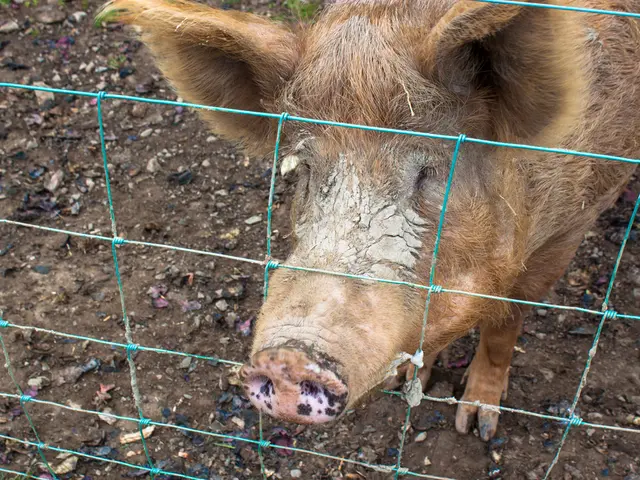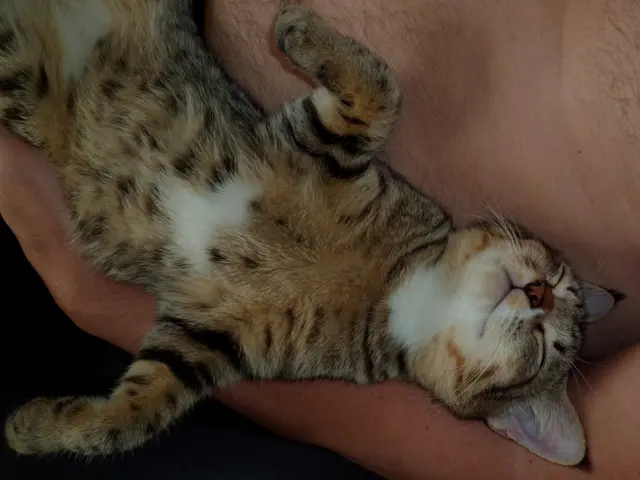Deadly Avian Influenza Spreading to Cats, Significant Risk for Human Transmission
University of Maryland researchers have unveiled a concerning trend: an escalating number of cats are contracting and dying from avian influenza, or bird flu. This virus, historically confined to poultry farms, has evolved to become deadlier and more widespread, jumping across species and geographical boundaries.
Dr. Kristen Coleman, the lead author of the study and an assistant professor at the University of Maryland School of Public Health, stated, "The virus has evolved, and the way it jumps between species—from birds to cats, and now between cows and cats, cats and humans—is very alarming."
Over a 20-year period from 2004 to 2024, her team's global review of scientific literature found 607 confirmed cases of bird flu in cats, with over half—302—fatal. Given that the numbers likely represent a significant undercount, the situation may be even graver.
Understanding the Trend
Traditionally, bird flu is primarily a bird disease, as the name suggests. However, since 2020, a particularly aggressive version—clade 2.3.4.4b—has emerged, facilitating the virus's perilous leap into mammals. In the last two years alone, feline infections have surged, with most cases now linked to this highly pathogenic strain.
Cats appear to be particularly vulnerable to bird flu, with severe complications including brain inflammation, blindness, and sudden death. "Bird flu is very deadly to cats," Coleman stated in a press release. "We urgently need to understand the extent of this virus in cat populations to better assess the spillover risk to humans."
The sources of infection have become increasingly diverse. Cats can contract the virus by consuming infected birds, feeding on contaminated poultry waste, drinking unpasteurized milk from sick dairy cows, or, most worryingly, through unknown routes. Two indoor-only cats in Colorado tested positive despite no known exposure to sick animals, raising concerns about new and unknown means of transmission.
Rising Human Risk
Though bird flu has infected 950 people globally, killing approximately half, human-to-human transmission has not been documented. But scientists worry that the virus could acquire this ability as it continues to spill over into various species, particularly those living in close proximity to humans.
Cats, which are ubiquitous—roaming farms, lounging in living rooms, shelters, and zoos—may serve as potential intermediaries, or "mixing vessels," for future viral evolution. In 2016, a different strain of bird flu spread among cats housed in a New York City shelter, ultimately infecting two people. Preliminary air and surface samples from the quarantine facility showed the virus may have spread via airborne particles or contaminated objects.
Although that outbreak was swiftly contained, experts fear a more virulent strain could prove far more challenging to manage.
A Global Map of Undetected Cases
The research team's findings, published in Open Forum Infectious Diseases, are based on 48 studies across 18 countries, studies covering 12 cat species, from domestic tabbies to zoo-kept tigers. They found that the majority of infections occurred in Asia, followed by Europe and North America. Bird flu has also been reported in lions, lynxes, caracals, and bobcats.
Despite the number of infections identified, most cats go undetected due to the rarity of bird flu suspicion, even when animals display neurological symptoms, and limited postmortem testing. The researchers estimate that the virus's spread among cats is dramatically underreported, urging increased cat surveillance to better evaluate spillover risk to humans.
Part of the problem lies in diagnostic confusion: bird flu often triggers encephalitis—swelling of the brain—which can mimic rabies. In many clinics, a cat exhibiting off-kilter behavior or blindness is more likely to be euthanized than tested.
New Routes, New Hosts
One of the most troubling discoveries is the virus's growing ability to evade traditional modes of transmission. It used to be thought that mammals contracted bird flu exclusively through the consumption of infected animals. However, recent infections in dairy cows—herbivores that do not eat meat—suggest otherwise. In April 2024, twelve barn cats at a Texas dairy died after consuming raw milk from infected cows, indicating that the virus might spread via milk. In December 2021, 20 exotic cats died at a sanctuary in Washington State, likely due to contaminated feed.
As the virus continues to mutate, its capacity to infect new species appears to be expanding, offering opportunities for viral evolution that could include the development of transmissible strains among humans. Even the Food and Drug Administration (FDA) has issued warnings to pet food manufacturers using raw poultry or cattle products, citing confirmed cases of bird flu linked to raw pet diets in several western states.
Next Steps
Coleman and her team are advocating for routine monitoring of bird flu in domestic cats, particularly in high-risk areas like dairy farms, animal shelters, and zoos. They also recommend that veterinarians consider bird flu when diagnosing cats with neurological symptoms.
"Our future research will involve studies to determine the prevalence of HPAI and other influenza viruses in high-risk cat populations such as dairy barn cats," said Ian Gill Bemis, co-author of the study and a doctoral student at the University of Maryland.
While a feline vaccine does not currently exist, researchers believe the time may be right to develop one.
- The University of Maryland researchers have highlighted an unsettling trend, the escalating number of cats contracting and dying from avian influenza.
- The avian influenza, historically confined to poultry farms, has evolved to become deadlier and more widespread, hopping across species and geographical boundaries.
- Cats seem particularly vulnerable to avian influenza, with severe complications like brain inflammation, blindness, and sudden death.
- Over a 20-year period from 2004 to 2024, global research uncovered 607 confirmed cases of bird flu in cats, with over half (302) being fatal.
- The virus leaped into mammals through a particularly aggressive version—clade 2.3.4.4b—that emerged since 2020, causing a surge in feline infections.
- The sources of infection have become increasingly diverse, with cats contracting the virus from feeding on contaminated waste, consuming infected birds, or, worryingly, through unknown routes.
- The spillover risk to humans is concerning, as cats may serve as potential intermediaries for future viral evolution.
- The virus's spread among cats is likely dramatically underreported due to the rarity of bird flu suspicion and limited postmortem testing.
- The virus's growing ability to evade traditional routes of transmission is troubling, with recent infections in herbivores like dairy cows indicating the virus might spread via milk.
- As the virus continues to mutate, it appears to be gaining the capacity to infect new species, offering opportunities for viral evolution that could include the development of transmissible strains among humans.
- To combat this issue, the researchers advocate for routine monitoring of bird flu in domestic cats, particularly in high-risk areas like dairy farms, animal shelters, and zoos.
- Future research will focus on determining the prevalence of Highly Pathogenic Avian Influenza (HPAI) and other influenza viruses in high-risk cat populations such as dairy barn cats, and the possibility of developing a feline vaccine.








